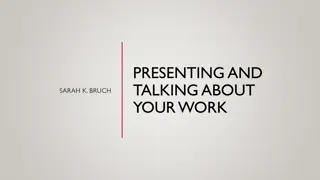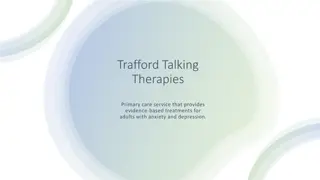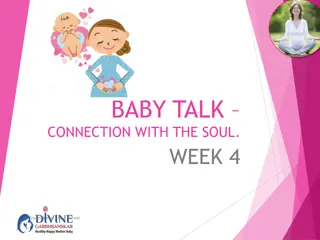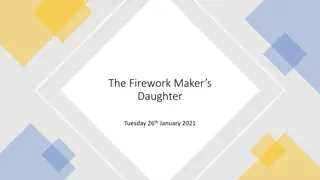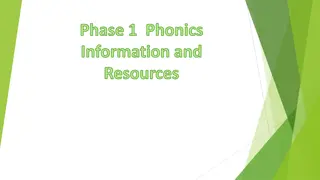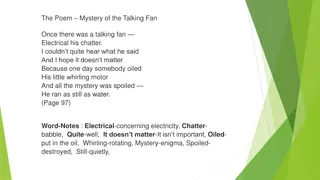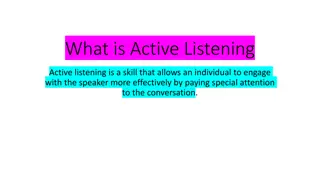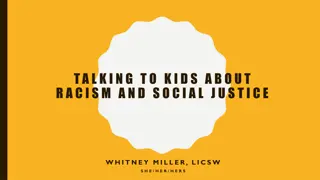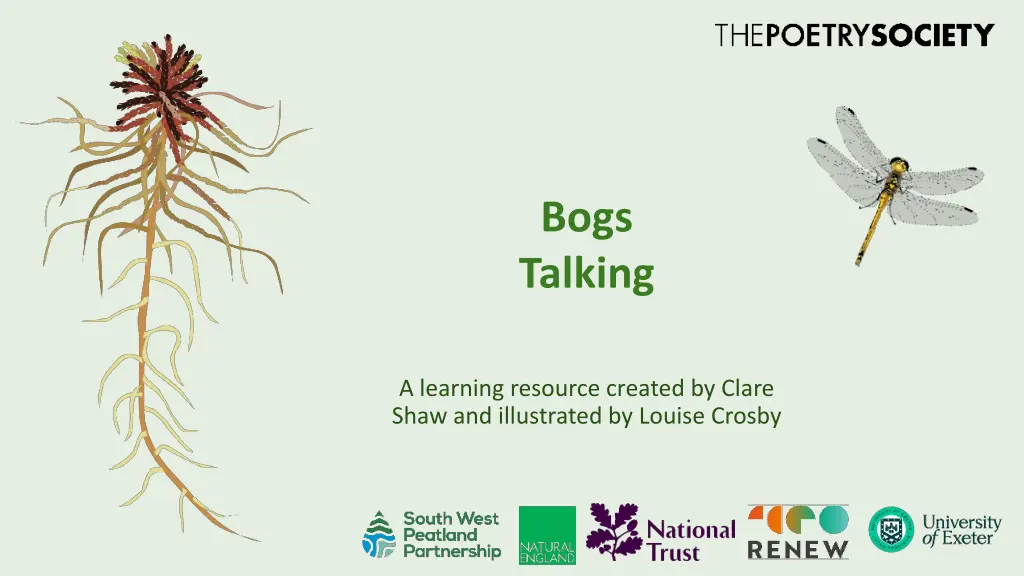
Exploring Bogs: A Unique Learning Resource
Dive into the fascinating world of bogs with "Bogs Talking," a learning resource by Clare Shaw, illustrated by Louise Crosby. Understand the significance of bogs, explore their characteristics, and learn how living beings have adapted to thrive in these wet habitats. Uncover the mysteries of bogs, discover the diverse flora and fauna that call bogs home, and engage in sensory activities to truly experience the essence of these unique landscapes.
Download Presentation

Please find below an Image/Link to download the presentation.
The content on the website is provided AS IS for your information and personal use only. It may not be sold, licensed, or shared on other websites without obtaining consent from the author. If you encounter any issues during the download, it is possible that the publisher has removed the file from their server.
You are allowed to download the files provided on this website for personal or commercial use, subject to the condition that they are used lawfully. All files are the property of their respective owners.
The content on the website is provided AS IS for your information and personal use only. It may not be sold, licensed, or shared on other websites without obtaining consent from the author.
E N D
Presentation Transcript
Bogs Talking A learning resource created by Clare Shaw and illustrated by Louise Crosby
Learning outcomes: Understand the characteristics of bogs, their importance and how living things have adapted to live there. Explore the use of kennings,alliteration, repetition, onomatopoeia in a poem. Use a selection from these techniques to write a poem about bogs and their sounds.
Mystery Today we are going to learn about an extraordinary landscape where you might find: - treasure - flesh-eating plants - dead people - creatures returned from extinction - a landscape that can help stop climate change and save the world. What landscape do you think we are going to learn about? The landscape is called a bog . Have you heard the word bog before? What do you think it means?
What are bogs? A bog is a kind of habitat that can form wherever the land is very wet if there is a lake or a river nearby, or where it is rainy and the land never gets dry. Because the land is so wet, water-loving plants grow there. When those plants die, they are covered in water, which stops them from rotting. Over years, all those slimy dead plants get squashed together and they form a special kind of soil known as peat. In some bogs, that peat can be very, very deep though it grows very slowly - just 1mm a year.
What are bogs? There are other words for bogs. bog comes from an old Irish word bogach meaning soft. swamp this is an American word for a type of bog where trees grow. The word swamp comes from an old Germanic word swampuz meaning sponge. Can you see how these two ideas ( soft and sponge ) are related? Other names are marsh, fen, mire, moss all of these are wet places but have their own characteristics.
Starter activity: using the senses Because a bog is so wet, it can be very muddy. Imagine you are walking through a bog. What does it look/ sound/ feel/ smell like? Write your answers like this A bog looks A bog sounds A bog feels A bog smells What other words do you associate with bogs? For example: moss, ooze, exciting, brown, green, deep, dark. Hangingstone Hill, Dartmoor by Rachael Land
The bog is a rich habitat A bog is an example of a habitat, which means a type of environment where plants and animals live. Some of the living things you might find in a bog include: Over one hundred different plants, including sphagnum moss, sundew, and bog cranberry. Over two hundred different invertebrates (creatures without a backbone) Birds and mammals, including dragonflies, Common Lizards, Adders, Short-eared Owls, and rare moths and butterflies.
The bog is a special environment The peat is waterlogged, so air cannot reach the dead plants and they do not rot. This means they hold on to carbon. This wet acidic soil can also preserve objects like boats and treasure and even bodies like the Lindow Man.
Photos of Hangingstone Hill, Amicombe, and Black Hill bogs, Dartmoor. Photos by Rachael Land.
The bog is a special environment The peat has also become home to creatures we don t find anywhere else. That s because of a process called adaptation. Living things adapt to their habitats. They have features that help them to survive in that place, like polar bears with their thick fur to survive in the cold Arctic regions. Can you think of other animals or plants that have adapted to the home they live in?
In the bog, plants and animals have to adapt to the watery conditions, acidic soils, and the lack of food (nutrients) and oxygen in the soil. For example: Carnivorous (meat-eating) plants like sundew and butterwort. They catch their own food in the form of insects because they can t get enough nutrients from the soil. Tough plants like heather, bog cranberry and rosemary keep their leaves all year so that they can draw more energy from the sun. Sphagnum moss can hold up to twenty-six times its own weight in water that s three times more than a sponge! Storing this water helps it survive if the bog dries in the summer. sphagnum moss sundew
Top left: sphagnum moss. Right: sundew. Bottom left: hares tail. Photos by Rachael Land.
More examples of adaptation Camouflage - The golden plover lays speckled eggs so they cannot be seen easily. The chick s feathers make them look exactly like the moss they live in so predators can t spot them and eat them. Lots of invertebrates are adapted to the oxygen-poor water - like darters, dragonflies, skaters. golden plover eggs dragonfly
Whilst each creature is extraordinary in its own right, what is most extraordinary about bog life is that everything depends on everything else. This is called an ecosystem. Humans are part of that ecosystem too. We depend on bogs because they store carbon. Peat only covers a tiny 3% of the world but holds twice as much carbon as the forests of the world so it s very important. If we protect bogs, they will hold on to that carbon and not release it into the atmosphere. This makes them an important tool to protects us from climate change.
Lets do some poetry! We are now going to read and write some poems about bogs. Earlier on, we thought about what a bog might look, sound, feel or smell like. We are going to focus on sound for the rest of the lesson. Poetry asks us to listen very hard, and it gives us a way of recording what we hear. Let s start by thinking about rhyme. Rhyme is one of the tools we use in poetry. Rhyme can help us memorise a poem or create links between different ideas. ACTIVITY: How many words rhyme with bog ? Write down as many as you can. (extra how many words rhyme with peat )
Not all poems rhyme. Some use sound in other ways, for example: alliteration, when lots of words that appear close together start with the same letter or sound repetition, when the same word or phrase is repeated onomatopoeia, when a word sounds like the noise it describes, like whoosh or buzz ACTIVITY: Switch on your ears what can you hear right now? Write a list of everything you can hear. Now, compare your list with the rest of the class. Did anyone hear something you didn t? Did anything surprise you?
Daughter of the Sea bog seeper moss creeper growing restless getting steeper trickle husher swish and rusher stone leaper splash and gusher foam flicker mirror slicker pebble pusher boulder kicker still pool don't be fooled shadow tricker keeping cool leap lunger crash plunger free fall with thunder under idle winder youth behind her little wonder daily grinder garbage binner dump it in her never mind her dog s dinner plastic bagger old lagger oil skinner wharf nagger cargo porter weary water tide dragger long-lost daughter of the sea the sea the sea has caught her up in its arms and set her free Reading a poem Let s look at a poem. Here is Daughter of the Sea , by Philip Gross (used here by permission of the author) The actual shape of the poem is shown here It is shown bigger on the next slide so you can read it.
Daughter of the Sea, by Philip Gross bog seeper moss creeper growing restless getting steeper leap lunger crash plunger free fall with thunder under idle winder youth behind her little wonder daily grinder garbage binner dump it in her never mind her dog s dinner plastic bagger old lagger oil skinner wharf nagger cargo porter weary water tide dragger long-lost daughter trickle husher swish and rusher stone leaper splash and gusher foam flicker mirror slicker pebble pusher boulder kicker of the sea the sea the sea has caught her up in its arms and set her free still pool don't be fooled shadow tricker keeping cool
ACTIVITY: With a partner, take a few minutes to talk about the following questions: What is this poem about? Can you find any rhyme, repetition, alliteration or rhythm? Underline or colour code them. How has the poet used sound in this poem? What is the effect of the way the poet uses sound? Does the poem remind you of a river in any way? Hint: look at the way the poem is laid out on your worksheet.
The poem uses a form called a kenning. This is a form used in Old English and Old Norse poems. It is when you combine two words to make a new noun. Examples in this poem include pebble pusher and boulder kicker. TICK all the kennings in the poem. If we were to think of some kennings for bogs, we might think of carbon storer secret keeper people-sinker Can you come up with any others?
Collecting ideas for writing a poem We are going to write our own poem. Like Philip Gross, we will think about how to create different sounds. While he wrote about the river, we will write about bogs. Listening to the bogListen to this clip of sounds recorded in a bog by artist Kathy Hinde. Kathy made this recording by putting a special underwater microphone called a hydrophone in the bog. What sounds can you hear? Come up with three similes to describe what you can hear. Similes are when we describe something using a comparison. For example, the sea sounds like my dad snoring . 1. The bog sounds like 2. The bog sounds like 3. The bog sounds like
What else can we hear in a bog birds? One especially lovely sound we might hear in a bog is birdsong. On a bog, we might find fifty or sixty different species of birds! We are most likely to hear: Curlews Skylarks Short eared owls Buzzards Swifts Starlings Black headed gulls Oystercatchers Meadow pipets Golden Plovers
Poets have struggled for years to capture what birds sound like. Over two hundred years ago, a poet called John Clare wrote about the difficulty of trying to capture the song of a nightingale in words. He said many of the nightingale s notes are sounds that cannot be written in the alphabet . In one of his poems, he tries to solve the problem! Chee chew chew chew and higher still Cheer cheer cheer cheer more loud and shrill Cheer up cheer up cheer up and dropt Low tweet tweet tweet jug jug jug and stopt Extract from 'The Progress of Rhyme' by John Clare
Lets see if you can do any better ACTIVITY: Choose one of the birds from the list on your worksheet and look it up in this directory of bird sounds. Listen to the sound the bird makes. As you listen, think about: What does this bird song make you feel? Does it make you think of any memories or stories? Can you write down the sounds like John Clare did? What do you think the bird is trying to tell us? What would it say if it could?
What might the bog itself say? Phillip Gross showed us how a river has lots of voices so does the bog. How do we capture those voices in poetry? ACTIVITY: In a group, discuss these questions: If we could hear the bog s voice, what would it sound like? What would the bog want to tell us? Would it tell us its stories about the strange ancient tribes who lived there? About the kings and treasures buried there? About the people who visit it and what they say and do there? Would it tell us about the animals and insects who live there? Would it want to give us a message about how we treat it, and what it wants from us? Would it want to give us a warning, or a blessing? Write three ideas down the bog wants to tell us.
Writing a poem ACTIVITY: Write your poem about the bog. You can choose whether to write it in the voice of the bog, or as a visitor to the bog, describing it. Really concentrate on the sounds of your poem. You could include some of these: the kennings you came up with to describe a bog the similes you created when you were listening to the bog sounds some of the poetic features that emphasise sound, like rhyme, onomatopoeia or alliteration. Are there words that sound deep, or squelchy? rhythm or repetition to create noises like footsteps or wingbeats birdsong, like John Clare did speaking from the point of view of the bog itself
Final thoughts Today we have learned about what a bog is and why bogs are important. We have read a poem about rivers and written our own sound-based poem about bogs. ACTIVITY: If you could give the whole world a message about bogs, what would that message be?
Useful Links https://soundcloud.com/kathy-hinde/deep-listening-walk-in-the-flow-country https://www.british-birdsongs.uk/alphabetical/ https://www.moorsforthefuture.org.uk/enjoy-the-moors/what-to-see-moorland-species/bogtastic-trump- cards https://cdn.buglife.org.uk/2019/07/Bogs-for-Bugs.pdf https://southwestpeatlandpartnership.co.uk/ https://renewbiodiversity.org.uk/ https://poetrysociety.org.uk/education/


